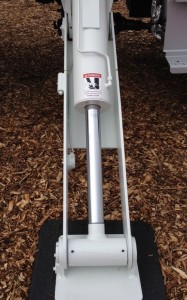 Hydraulic cylinders are typically built to handle high loads in rugged and demanding operating conditions, and they routinely last for years. Unfortunately, cylinders used improperly face a quick demise. Mechanical issues like side loading and rod bending are two common cylinder problems that lead to premature failure.
Hydraulic cylinders are typically built to handle high loads in rugged and demanding operating conditions, and they routinely last for years. Unfortunately, cylinders used improperly face a quick demise. Mechanical issues like side loading and rod bending are two common cylinder problems that lead to premature failure.
Cylinders are designed to provide linear force and motion to move a load. A cylinder works well when compression and tension forces perfectly align in the rod’s axial direction. Side loading occurs when a mass or external force pushes the rod to the side, up or down.
When a cylinder retracts, it normally has high resistance to side load, not only because bending forces are low, but because the rod is supported by a bushing in the head and the piston itself inside the cylinder bore. But as the cylinder extends, the piston moves closer to the head. That reduces the capacity for the piston to act as a bearing, increasing the potential lever arm and the opportunity to bend the rod.
The longer the cylinder stroke and the further the rod extends along its stroke, the higher the potential for side loading and column bending.
Fixed-mount cylinders do not function well if rod travel is out of alignment. In fact, side load is probably the most common cause of rod-bearing failure. It causes uneven wear, as the rod pushes into one side of the bushing and the piston drags with more force across one side of the barrel. Eventually, surfaces will suffer damage, resulting in shorter bearing life, fluid leaks and seal failure.

Side loading on a cylinder rod, particularly when the rod is extended, can damage the cylinder and diminish its useful life. Image courtesy CD Industrial Group
In more extreme cases side loads can bend the rod, particularly when using an undersized rod in a thrust application. The rod must be strong enough to withstand stresses imposed by the load and cylinder. Thus, correct rod size and strength are important factors in sizing a cylinder. If the piston rod diameter is too small in relation to the load column, bending failure or rod buckling is likely.
Fortunately, engineers can improve cylinder performance with regards to both side load and column strength. Here are some options:
- Alignment. There is no substitute for precision alignment. When mounting a cylinder, technicians need to check and minimize misalignment in both extended and retracted positions.
- Guiding. Particularly in horizontal and long-stroke applications, users must ensure that loads are properly guided and the rod has adequate support, to eliminate side loads.
- Mounting. One possible solution is to use a clevis or trunnion-mounted cylinder that moves with the side load. Also, note that head-style mounts provide greater column strength than comparable cap-end mounts, due to the shorter distance between mounting points.
- Misalignment compensation. To handle slight misalignment, a cap spherical bearing mount or spherical bearing rod eye sometimes helps. But they often require larger diameter piston rods or longer stop tubes to compensate for higher bearing stresses caused by loss of rigidity between piston rod and the moving load.
- Larger rod. A larger diameter rod improves overall rod strength, making it less susceptible to bending. However, stop tubes are generally more effective, less expensive, and lighter than oversized piston rods.
- Stop tube. Another technique is to add a stop tube. This is simply a tube inserted inside the cylinder and around the rod between the piston and head. It acts like a spacer to prevent the cylinder from extending completely. This increases the distance between the two bearing areas—the piston and rod bushing—reducing the effects of side loading and maintaining high buckling resistance. However, adding a stop tube reduces usable stroke length. Thus, users may need to opt for a cylinder with longer stroke than would otherwise be necessary.
Filed Under: Cylinders & Actuators, Fluid Power Basics